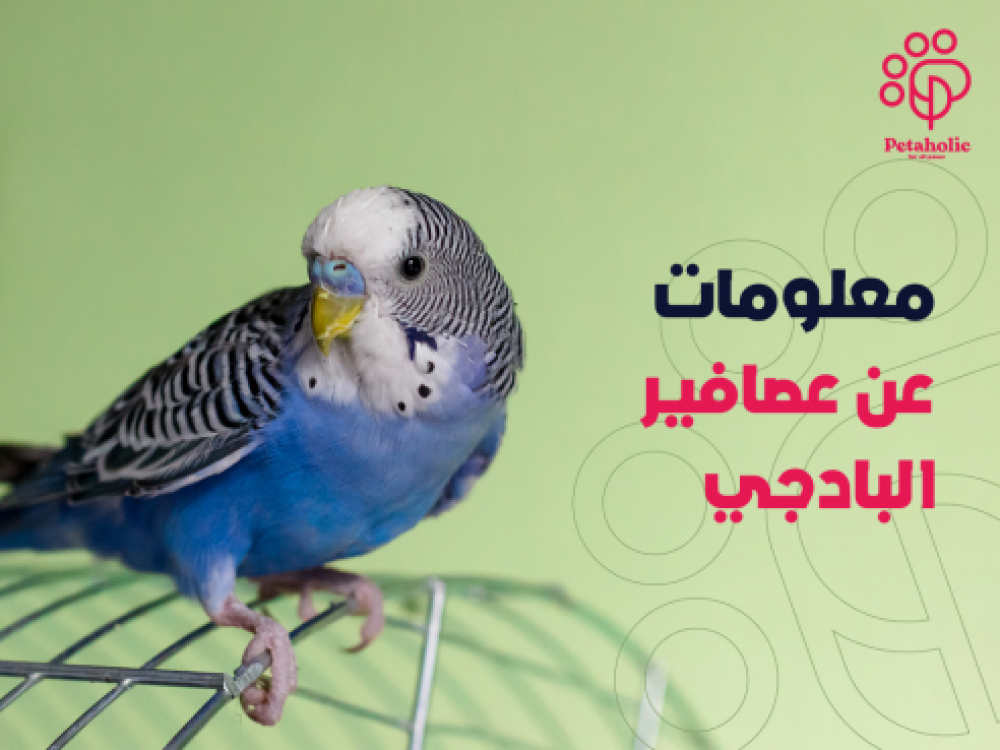
Are you a beginner in the world of birds? If you are looking for a pet bird that is easy to handle and raise, look for budgies, which are characterized by spreading joy in the home in more ways than one. In this guide, we'll dive into everything you need to know about them if you're going to raise them. Also, if you already own budgies, this guide will help you a lot. On our distinguished store, Petaholic, you will find all the bird and pet supplies you need, while we also present during our article today the most important information about budgerigars.
Information about budgerigars and what are they?
When searching and checking about the most important information about budgerigars, it became clear to us that the budgerigar is one of 115 species of parrots and is commonly known as the love bird. These seed-eating birds have a slender body and long, tapering tails. They also feature light green bodies, with some waves of yellow on the head, and striking black and white plumage on the wings. These birds are called macaws or scalloped parrots because of the wavy, seashell-like formation on their wings. These finches are one of the smallest parrots, with an average length of 18 to 20 cm.
Budgerigars are social creatures that are friendly and playful by nature. They like to pair up in the wild or live in small colonies when they are not migrating. These birds also take care of each other when resting and communicate using a distinctive chirping sound. When raising budgies in homes, they are playful and outgoing, and enjoy spending time and communicating with their favorite humans. Therefore, they are easy to care for, which makes them great pets for children and adults.
These birds are relatively short-lived in the wild, spending between 4 and 6 years in the wild. But when raised in homes, they can live longer, ranging from 7 to 15 years.
Some of the featured products we offer for petaholic parrots are:
What are the most common types of budgies?
There are two main types of budgies that are kept in homes.
Australian budgerigars
Australian budgies are relatively small and more closely related to wild parrots. They are also very noisy, more difficult to train and control their behaviour, and more likely to pinch fingers with their beaks. Therefore, it may not be suitable for those who are looking for a quiet, non-noisy or annoying pet bird.
Information about English budgerigars
In this part, we provide you with information about English budgerigars, which we advise you to raise in your home because they are better than their Australian counterparts. These birds are longer than the Australian, and have larger heads. In addition, they have puffy feathers around their faces and crowns. English budgies are usually quiet and often bred for their appearance, often used in bird shows. It is also distinguished by its many bright colors.
Among our distinctive range of bird supplies, we recommend for your pet birds:
What are the most common colors of budgerigars?
Budgies come in different colors and markings, making them one of the most colorful pet birds around. Some common colors include green, blue, yellow, white and black. It can also have a variety of marks, including lines, spots, and ripples.
Australian budgies have green and yellow colors with black stripes. The wing and tail feathers are a mixture of blue, green and black. As for the English parrot, it can come in different colors thanks to the mutations that are born in the bird. There are 32 different color mutations that were obtained intentionally for commercial purposes.
If you want the best care for your pet birds, we recommend:
What food for budgerigars do these birds prefer?
It is very easy to feed budgies with a mixture of high quality parrot food, providing a balanced diet by incorporating fresh seed with the food. Always make sure to purchase a mixture similar to what the bird was fed before you owned it. It is very important to check the food and water containers daily, as the budgie peels the seeds it eats and leaves the empty husks on top of the seed dish. Therefore, these husks must be discarded and the uneaten seeds beneath revealed. Millet sprays can also be provided in small quantities as rewards, but don't exceed this as it can cause obesity.
Cuttlefish bones should also be offered as they provide calcium and other minerals that may be deficient in the seed diet. Small amounts of fresh green food in the form of well-washed pieces of fruit and vegetables can also be provided. However, you should always wash this food because toxic pesticides can remain on it and harm birds, which are very sensitive to these pesticides.
If you want the best diet for your budgies, we at Petaholic offer you:
Budgies breeding and mating
Budgies are distinguished by their mating for life with only one companion. Their breeding season occurs at any time, but mostly after it rains. Sparrows build their nests from hollows in tree trunks and branches. Female budgies reach maturity when they are eight months old. She also lays about 4 to 8 eggs at a time, which she incubates for 18 to 20 days. Sometimes, it may take another week to 10 days before all the eggs hatch.
Because young budgies are born blind and with minimal feathers, their mother needs to keep them warm for the first 10 days or so until their eyes open. On the other hand, the father is busy searching for food to feed the young. The young begin to learn to fly and attempt to escape from the nest between 6 to 8 weeks. The number of young in the nest also affects the age at which a young sparrow can fly.
How do you help budgies adapt to their new home?
The cage you choose for your finches should be suitable for them. It should also be large enough to place some activity toys without restricting the birds' space. In general, the larger the cage, the better. You can follow these steps in order to transfer the budgie from its old cage to the new cage that you have allocated for it:
- Place the cage in a room with a fairly even temperature, not near windows as this can cause it to be more exposed to temperature changes.
- It should be placed where small children and other pets cannot reach it.
- Make sure the cage is fully stocked with food and water, and a small amount of seed should be sprinkled on the floor of the cage to ensure the bird has enough food as it searches for food containers and explores the cage.
- Make sure all windows and doors are closed.
- Don't try to force the bird to enter or click on the box, just let it do it by itself and take its time.
- If your budgie does not settle quickly, place a light piece of cloth over the cage covering three sides to provide an extra sense of security.
To help your birds quickly adjust to their new home, we recommend:
- Orient pet bird cage 35×33 cm
At Petaholic, we provide you with the highest quality bird and pet supplies you need to ensure the well-being, safety and health of your little friends at the lowest prices.

